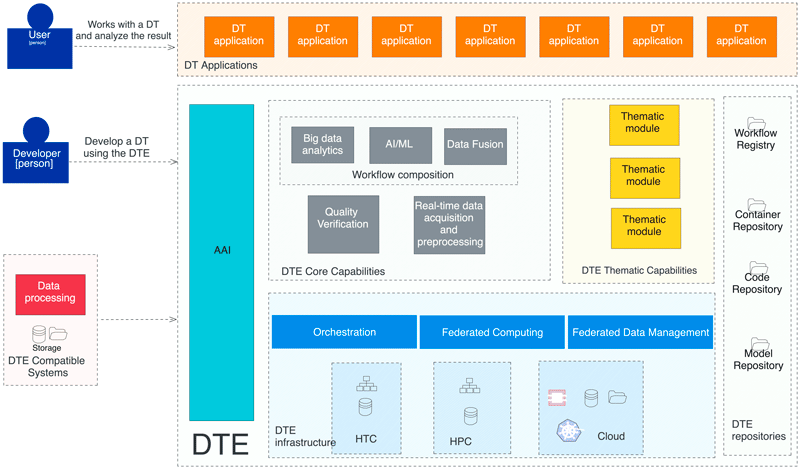by Andrea Manzi, Raul Bardaji and Ivan Rodero (EGI.eu)
The paper reviews the need to create a ‘Digital Twin Engine’ to support developers in reusing modular components to speed up the building process of Scientific Digital Twins. It highlights how the interTwin project leads this effort by providing a robust framework that cuts development time, supports scalability, and promotes collaboration between domains. Furthermore, the article highlights some ongoing use cases based on this Digital Twin Engine, showing the use and potential impacts.
The increasing demand for accurate simulations and real-time decision-making in various fields has positioned Digital Twins (DTs) as a transformative technology. By creating virtual replicas of physical systems, Digital Twins enable simulation, monitoring, and prediction across domains such as environmental management, healthcare, and industrial operations. Despite their potential, the creation of Digital Twins often faces significant challenges. These include the complexity of integrating heterogeneous data sources, the high computational demands, and the lack of standardised frameworks that enable the reuse of components and collaboration across projects.
To address these obstacles, the European project interTwin introduces an innovative Digital Twin Engine (DTE). This modular framework is designed to simplify the development of DTs by enabling the reuse of existing components, ensuring interoperability, and providing a scalable infrastructure. The DTE Blueprint Architecture, rooted in open standards and co-designed with diverse scientific communities, supports the seamless integration of DTs into various applications.
This article explores the necessity of a DTE to accelerate the adoption of DTs, examines how the interTwin project has developed its DTE and presents case studies showcasing its use and impact.
The Digital Twin Engine from interTwin
The DTE developed by the interTwin project represents a significant step forward in addressing the challenges of creating and scaling DTs. By integrating modularity, interoperability, and federated infrastructures, the DTE provides a streamlined approach to overcome the complexity of data integration and the heterogeneity of computational resources, making the development of DTs more efficient and accessible.

Figure 1: the interTwin Digital Twin Engine Blueprint architecture.
Figure 1 provides an overview of the DTE, highlighting its main components made available to facilitate the development and operation of DTs.
At the core of the DTE, as depicted in the central section, are fundamental capabilities such as data fusion, big data analytics, and the integration of artificial intelligence and machine learning (AI/ML). These capabilities are organised within a workflow composition system. The DTE core modules include DT output quality verification, real-time data acquisition and preprocessing and well.
At the base of the DTE lie components dedicated to federated resource management. These include orchestration, federated computing, data management, connecting high-performance computing (HPC), high-throughput computing (HTC), and cloud storage systems. This modular design allows the DTE to adapt to the specific needs of each DT, ensuring scalability and operational efficiency.
At the top, the DT applications, which serve as user-facing interfaces for analysing results and making decisions based on simulated data. These applications are supported by thematic capabilities, which include specialised modules tailored to specific domains, such as data integration, advanced simulations, and domain-specific tools.
The first version of the components has been released as Open Source and is available for installation and use via the project’s website [L1]. A more detailed description of the DTE components can be found in [1].
Use cases with the Digital Twin Engine
The following use cases are developing DTs using the interTwin DTE and demonstrate the flexibility and adaptability of its modules to various needs, as well as their potential to drive innovation across various scientific disciplines:
- FloodAdapt Deployment: This initiative focuses on creating a Digital Twin for flood impact modelling that can be implemented globally. By integrating rapid, physics-based compound flood modelling with detailed impact assessments, FloodAdapt enables non-expert users to evaluate various flood scenarios and adaptation strategies efficiently.
- Virgo Gravitational Wave Interferometer Noise Simulation: In collaboration with Virgo, interTwin is developing a Digital Twin to simulate ‘noise’ within the interferometer. This simulation aids in understanding and mitigating noise sources, thereby enhancing the detection capabilities of gravitational waves.
- Flood Early Warning Systems: interTwin is advancing components to establish Digital Twins for flood early warning in coastal and inland regions. These systems utilise complex models and satellite data processing pipelines to monitor and predict flood behaviours, providing stakeholders with timely and accurate information.
- Tropical Cyclone Projection: By employing deep neural networks, interTwin is developing Digital Twins capable of detecting and projecting the occurrence of tropical cyclones under changing climate conditions. This approach enhances predictive accuracy and informs climate adaptation strategies.
- High-Energy Physics Particle Detector Simulation: interTwin is setting up a Digital Twin for fast particle detector simulation, facilitating more efficient data analysis and experiment planning in high-energy physics research.
Conclusions
The DTE demonstrates how a modular, interoperable, and scalable framework can overcome important challenges in the development and deployment of DTs. By leveraging federated infrastructures, integrating advanced capabilities like AI/ML and data fusion, and adhering to open standards, the DTE simplifies the creation and operation of DTs across diverse domains. Use cases like flood impact modelling, gravitational wave interferometer noise detection, and high-energy physics detector simulations illustrate its flexibility and potential to drive innovation. Looking ahead, the DTE aims to serve as a foundation for collaborative and efficient DT development, enabling broader adoption and impact across scientific disciplines.
Acknowledgements
Although this paper accepts only three authors, the interTwin project represents the collective effort of all participating entities. This article summarises the work accomplished, and its content belongs to everyone involved in the project. We acknowledge the invaluable contributions of all team members and collaborators developing the interTwin DTE.
Link:
[L1] https://www.intertwin.eu/
Reference:
[1] https://www.intertwin.eu/intertwin-digital-twin-engine
Please contact:
Andrea Manzi
EGI Foundation, The Netherlands











